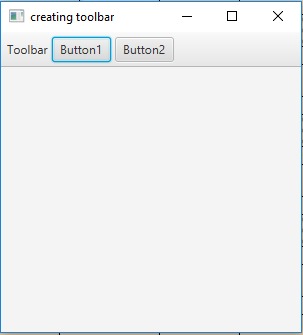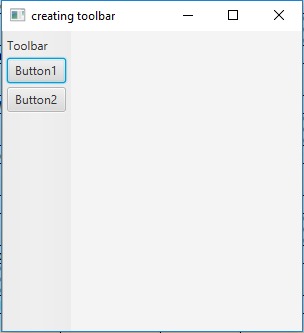ToolBar类是JavaFX的一部分。工具栏是一个控件,可垂直或水平显示项目。通常将按钮,切换按钮和分隔符放置在工具栏中。您也可以在其中插入任何节点。如果工具栏中有太多项目无法容纳,则会出现“溢出”按钮,从而允许选择工具栏中当前不可见的项目。工具栏将focusTraversable设置为false。
该类的构造函数:
- ToolBar():创建一个空的工具栏。
- ToolBar(Node… n):创建一个填充有指定节点的工具栏。
常用方法:
| 方法 | 说明 |
|---|---|
| getItems() | 返回工具栏的项目。 |
| getOrientation() | 返回工具栏的方向。 |
| setOrientation(Orientation v) | 设置对象的方向值。 |
以下示例程序旨在说明ToolBar类的用法:
- Java程序创建工具栏并将其添加到场景中:在此程序中,我们将创建一个名为工具栏的工具栏。我们还将创建一个名为label的Label和两个分别名为button1和button2的Button,并将它们添加到工具栏。将工具栏添加到名为vbox的VBox并将VBox添加到场景。然后将场景添加到舞台上,并调用show()函数以显示结果。
// Java program to create a toolbar // and add it to the scene import javafx.application.Application; import javafx.scene.Scene; import javafx.scene.control.*; import javafx.scene.layout.*; import javafx.stage.Stage; import javafx.event.ActionEvent; import javafx.event.EventHandler; import javafx.scene.Group; public class Toolbar extends Application { // launch the application public void start(Stage stage) { try { // set title for the stage stage.setTitle("creating toolbar"); // create a label Label label = new Label("Toolbar"); // creating buttons Button button1 = new Button("Button1"); Button button2 = new Button("Button2"); // creating toolbar ToolBar toolbar = new ToolBar(label, button1, button2); // create a VBox VBox vbox = new VBox(toolbar); // create a scene Scene scene = new Scene(vbox, 300, 300); // set the scene stage.setScene(scene); stage.show(); } catch (Exception e) { System.out.println(e.getMessage()); } } // Main Method public static void main(String args[]) { // launch the application launch(args); } }输出:

- Java程序创建工具栏并将其添加到场景并设置工具栏的方向:在此程序中,我们将创建一个名为工具栏的工具栏。我们还将创建一个名为label的Label和两个分别名为button1和button2的Button,并使用getItems().add()函数将它们添加到工具栏。使用setOrientation()函数设置工具栏的方向。现在,将工具栏添加到名为hbox的HBox并将HBox添加到场景。最后,将场景添加到舞台上,并调用show()函数以显示结果。
// Java program to create a toolbar and // add it to the scene and set orientation // of the toolbar import javafx.application.Application; import javafx.scene.Scene; import javafx.scene.control.*; import javafx.scene.layout.*; import javafx.stage.Stage; import javafx.event.ActionEvent; import javafx.event.EventHandler; import javafx.scene.Group; import javafx.geometry.*; public class Toolbar_1 extends Application { // launch the application public void start(Stage stage) { try { // set title for the stage stage.setTitle("creating toolbar"); // create a label Label label = new Label("Toolbar"); // creating buttons Button button1 = new Button("Button1"); Button button2 = new Button("Button2"); // creating toolbar ToolBar toolbar = new ToolBar(); // add items toolbar.getItems().add(label); toolbar.getItems().add(button1); toolbar.getItems().add(button2); // set orientation of the toolbar toolbar.setOrientation(Orientation.VERTICAL); // create a HBox HBox hbox = new HBox(toolbar); // create a scene Scene scene = new Scene(hbox, 300, 300); // set the scene stage.setScene(scene); stage.show(); } catch (Exception e) { System.out.println(e.getMessage()); } } // Main Method public static void main(String args[]) { // launch the application launch(args); } }输出:

注意:以上程序可能无法在在线IDE中运行。请使用离线编译器。
参考:https://docs.oracle.com/javase/8/javafx/api/javafx/scene/control/ToolBar.html
相关用法
- JavaFX 类 Pos用法及代码示例
- JavaFX 类 Tab用法及代码示例
- JavaFX 类 FontWeight用法及代码示例
- JavaFX 类 TextAlignment用法及代码示例
- JavaFX 类 FileChooser用法及代码示例
- JavaFX 类 FlowPane用法及代码示例
- JavaFX 类 StackPane用法及代码示例
- JavaFX 类 LinearGradient用法及代码示例
- JavaFX 类 Popup用法及代码示例
- JavaFX 类 Stop用法及代码示例
- JavaFX 类 DirectoryChooser用法及代码示例
- JavaFX 类 Font用法及代码示例
- JavaFX 类 FontPosture用法及代码示例
- JavaFX 类 AnchorPane用法及代码示例
注:本文由纯净天空筛选整理自andrew1234大神的英文原创作品 JavaFX | ToolBar Class。非经特殊声明,原始代码版权归原作者所有,本译文未经允许或授权,请勿转载或复制。
